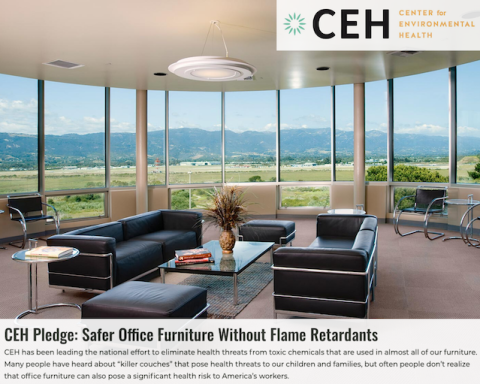UC Santa Barbara Pledges to Purchase Safe Furniture

Did you know that furniture can be a major source of toxic chemicals? The flame retardants, volatile organic compounds (VOCs), fluorinated compounds used for stain- or water-resistant treatments, polyvinyl chloride (PVC), and antimicrobials that are commonly used in furniture products present serious health consequences for us. These chemicals seep from our furniture products and accumulate into dust particles that circulate in our air and eventually end up in our bloodstreams. The chemicals can be released throughout the lifecycle of a product, from manufacturing, during use, and as part of the disposal process. There are serious health effects associated with exposure to these toxic chemicals such as cancer, obesity, neurodevelopmental and reproductive problems, as well as a variety of other health problems. These health implications may also affect future generations that have not been directly exposed to these chemicals.
To address this problem, UC Santa Barbara recently signed a pledge through the Center for Environmental Health to commit to purchasing safer furniture products to protect the health of the community and the global environment. This pledge went into effect February 2020 and specifies that UC Santa Barbara is committed to ensuring that its furniture suppliers’ products do not contain chemical flame retardants, antimicrobial treatments, any fluorinated compounds used as stain/water resistant treatments, or PVC. The pledge also expresses the preference for products that meet the highest standards for indoor air quality for volatile organic compounds (VOCs), including formaldehyde.
UC Santa Barbara has been working towards purchasing safer furniture products for a few years. In early 2016, our Sustainable Procurement Analyst, Heather Perry, began working with the Center for Environmental Health, a non-profit organization dedicated to protecting people from toxic chemicals by working with communities, consumers, workers, government, and the private sector to demand and support business practices that are safe for public health and the environment. The Center for Environmental Health’s Pollution Prevention Director, Judy Levin, presented research on the potential hazards many chemicals used in furniture can pose to human and environmental health, both during their manufacturing, as well as to the end-user and during disposal which led to UC Santa Barbara’s commitment to purchase safe furniture.
From the fiscal year 2017 to 2020, UC Santa Barbara has spent an average of $1.7MM annually on office furniture, about $3.9MM on all furniture total, including dorm and residential, lab, and classroom. Purchases for furniture are year-round, either to update old buildings or for new buildings on campus. The Center for Environmental Health highlights that flame-retardant-free furniture is more affordable than furniture that contains harmful chemicals because the added flame retardants cost more money. Avoiding fluorinated stain treatments and antimicrobials can also reduce the cost of the furniture. At UC Santa Barbara, as furniture is replaced due to reaching its end of useful life on campus, the old furniture is sent to UCSB’s Surplus Sales, where it can be purchased again by other departments on campus, or by students or the general public. If the used furniture is not purchased, it gets picked up and recycled or landfilled by Marborg.
UC Santa Barbara’s signing of this pledge exemplifies their commitment to protecting the health of all students, staff, and the wider community by reducing the potential exposure to harmful chemicals and toxins. Read more about the Center for Environmental Health Pledge here.